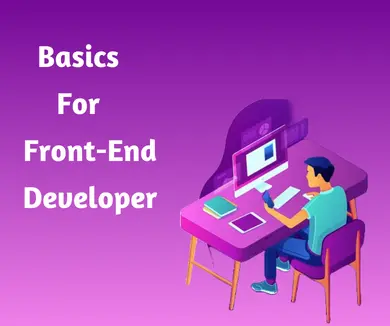What is Web Accessibility?
Web accessibility is the process of making a website and application accessible to everyone, regardless of physical or mental ability. It removes the barriers that limit or restrict a person’s access and use of online services or content.
Why web accessibility is important?
For front-end developers, accessibility is crucial as it guarantees that everyone, regardless of ability, can access and use the apps and websites that they develop.
Why Accessibility Matters to Front-end Developers?
Accessibility is a concern for front-end developers since it assures all users fair access to websites and the applications that front-end developers build regardless of the ability.
Equal Access: It guarantees that everyone has an equal probability of accessing the given information and resources.
Read more about accessible websites:
Better Usability: Accessible websites will typically be easier for all users to navigate than inaccessible ones
Future-Proofing: Accessibility ensures that websites remain compatible with the advent of new devices and tools as technology advances.
Ethical Responsibility: Access shows commitment to respect all people, regardless of their disabilities.
Improving a Business Reputation: Companies that consider access will improve their brand and attract more diverse customers.
How to Make Websites Accessible?
To make your website accessible there are few things to consider are font size, color, and layout.
Semantic HTML
Semantic HTML, also known as Semantic Hypertext Markup Language, is the use of HTML elements that explain the structure or meaning of the content they enclose rather than just describing how it should be displayed. In other words, it involves using HTML in a way that makes the content more understandable by humans and machines, such as search engines and assistive technologies like visually impaired devices.
When you are constructing the main section of your website. Your code ought to resemble this:
<main> <h1>Welcome to Our Web Page</h1> <p>Details regarding our web Page</p> </main>
Additionally, you can use the nav tag to navigate your web page.
<nav> <ul> <li><a href="#">Home</a></li> <li><a href="#">About Us</a></li> <li><a href="#">Contact</a></li> </ul> </nav>
Make use of visible colors and contrast
Using colors that are easy to understand and promoting appropriate contrast is crucial to creating inclusive web pages that all users, even those with visual impairments, can understand and read.
Key Tips for Using Accessible Colors and Contrast in Web Design
Check Contrast Ratios: The Web Content Accessibility Guidelines (WCAG) specify the contrast ratio requirements that must be met. The general contrast ratio requirement for large text is 3:1 and for normal text is 4.5:1.
Carefully Choose the Colors: Careful color selection is a fundamental aspect of web and graphic design. Color can convey emotions, create visual harmony, and impact the overall user experience. To check your design’s contrast ratio, click on this link.
Test Your Designs: Test your website on different devices and screen resolutions to ensure they display as expected. Colors and Font sizes may look different on different screens.
Use ARIA attributes: ARIA attributes are a group of HTML attributes used to improve the accessibility of web pages and web applications. ARIA attributes provide more details for assistive technologies.
Example of markup with aria Attributes
aria-label: This attribute provides a human-readable label for elements that may have no visible text.
<button aria-label="Search"> <i class="bi bi-search"></i> </button>
aria-hidden: This attribute can be used to hide elements from assistive technologies when they are purely decorative or redundant for screen reader users.
<span aria-hidden="true">x</span>
aria-controls: The associated div’s ID is referenced by the aria-controls attribute.
<button aria-controls="collapse">View More </button>
Text Alternatives are Essential
A fundamental principle of web accessibility is to provide text alternatives to ensure content is accessible to people with impairments, such as those who use screen readers or other assistive technology. Text alternatives for different kinds of non-textual content should be provided to make it perceptible and understandable.
Here’s what an alt text for video and image tags looks like in the code:
<div>
<h3>Video</h3>
<video src="video.mp4" alt="digital"></video>
<h3>Image</h3>
<img src="logo.png" alt="Digital world">
<figure>
<img src="commerce.png" alt="eCommerce">
</figure>
</div>
Focus Styles
Focus styles are now a design and accessibility consideration in UI (user interface) layout and development. People can use them to visually identify the selected or “in focus” component on a web page or application.
Key Thoughts on Focus
Keyboard Navigation: Focus styles make it easier for users to identify the interactive element they are currently focused on when interacting with web pages or applications through a keyboard (e.g., by hitting the Tab key to switch between dynamic elements).
Pseudo-class: In web development, focus styles are often implemented using CSS pseudo-classes, such as ‘focus’. Developers can apply specific styles to elements when they are in focus.
For example:
:focus {
border: 2px solid #007BFF;
border-radius: 4px; }
Mobile Device: Emphasis on style is essential for mobile and desktop web applications. Software Developers must consider the unique focus patterns and behaviors of mobile phones and tablets.
High Contrast: Ensure the focus style contrasts strongly with the background color or other nearby elements.
Animation: Animation highlights the target component. For example, you can make the background or border color carefully pulse or shift.
Color: Use color in conjunction with other visual elements like borders and underlines.
Touch Target Size: Remember, touch screen devices are how mobile device users interact. Make sure touch targets are large enough to be clicked easily.
Best Practices for Mobile Focus Styles
High Contrast: Ensure the focus style contrasts strongly with the background color or other nearby elements.
Animation: Animation highlights the target component. For example, you can make the background or border color carefully pulse or shift.
Color: Use color in conjunction with other visual elements like borders and underlines.
Touch Target Size: Remember, touch screen devices are how mobile device users interact. Make sure touch targets are large enough to be clicked easily.
Conclusion
Frontend developers have a fundamental obligation to consider web accessibility. A key step in achieving this goal is understanding basic web accessibility principles and putting them into practice.
In a world where the internet has become an important part of everyday life, making the internet accessible is not only good practice; it is also an obligation to build a more equitable and inclusive digital environment. Therefore, every front-end developer should consider web accessibility as an essential skill and strive to create digital experiences that truly leave no one behind.



